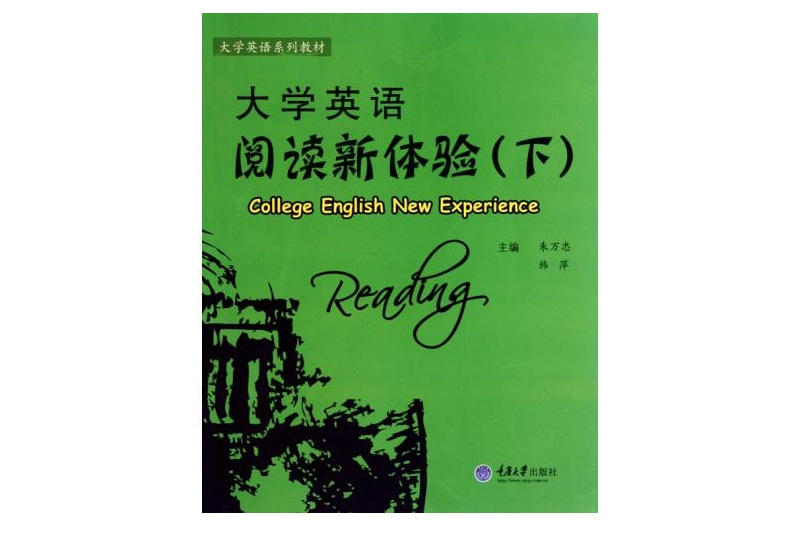內容簡介
《大學英語閱讀新體驗(下)》是大學英語系列教材。
圖書目錄
Unit One Understanding the Relationships within Sentences
part 1 Introduction to Skills
Example 1
Example 2
Example 3
Part 2 Timed Reading
Section A Information Confirmation
Section B Information Completion
part 3 Reading in Depth
Passage l
Passage 2
Part 4 Reading in the Context
part 5 Language Structure
Unit Two Identifying Authors Purposes
Part 1 Introduction to Skills
Example 1
Example 2
part 2 Timed Reading
Section A Information Confirmation..j
Section B Information Completion
part 3 Reading in Depth
Passage l
Passage 2
Part 4 Reading in the Context
Part 5 Language Structure
Unit Three Distinguishing Between Facts and Opinions
Part 1 Introduction to Skills
Example 1
Example 2
Part 2 Timed Reading
Section A Information Confirmation
Section B Information Completion
Part 3 Reading in Depth
Passage 1
Passage 2
Part 4 Reading in the Context
Part 5 Language Structure
Unit Four Understanding Text Structure
Part 1 Introduction to Skills
Example l
Example 2
Part 2 Timed Reading
Section A Information Confirmion
Section B Information Completion
Part 3 Reading in Depth
Passage 1
Passage 2
Part 4 Reading in the Context
Part 5 Language Structure
Unit Five Taking Notes
Part 1 Introduction to Skills
Example l
Example 2
Part 2 Timed Reading
Section A Information Confirmation
Section B Information Completion
Part 3 Reading in Depth
Passage 1
Passage 2
Part 4 Reading in the Context
Part 5 Language Structure
Unit Six Writing Summaries
Part 1 Introduction to Skills
Example
Part 2 Timed Reading
Section A Information Confirmation
Section B Information Completion
Part 3 Reading in Depth
Passage 1
Passage 2
Part 4 Reading in the Context
Part 5 Language Structure
Unit Seven Critical Reading
Part 1 Introduction to Skills
Example 1
Example 2
Part 2 Timed Reading
Section A Information Confirmation
Section B Information Completion
Part 3 Reading in Depth
Passage 1
Passage 2
Part 4 Reading in the Context
Part 5 Language Structure
Unit Eight Using Reference Sources
Part 1 Introduction to Skills
Example 1
Example 2
Example 3
Example 4
Part 2 Timed Reading
Section A Information Confirmation
Section B Information Completion
Part 3 Reading in Depth
Passage 1
Passage 2
Part 4 Reading in the Context
Part 5 Language Structure
Answers and Explanations
文摘
No visitor to the emerging world can fail to be struck by its prevailing optimism,particularly if his starting point is the recession-racked West. The 2009 Pew GlobalAttitudes Project confirms this impression. Some 94% of Indians, 87% of Brazilians and85% of Chinese say that they are satisfied with their lives. Large majorities of people inChina and India say their country's current economic situation is good, expect conditionsto improve further and think their children will be better off than they are. This is aregion that, to echo Churchill's phrase, sees opportunities in every difficulty rather thandifficulties in every opportunity.
In the past, emerging economic giants have tended to embrace new managementsystems as they tried to reinforce their progress. America adopted Henry Ford's productionline. Japan invented lean production and almost destroyed the American car and electronicsindustries. Now the emerging markets are developing their own distinctive managementideas, and Western companies will increasingly find themselves learning from their rivals.People who used to think of the emerging world as a source of cheap labor must nowrecognize that it can be a source of disruptive innovation as well.
序言
《大學英語閱讀新體驗》依據教育部新頒布的《大學英語課程教學要求》(試行)編寫,供大學英語基礎階段的教學使用。本教材分為上、下兩冊,適用於大學英語課程1~2年級教學使用。
該教材用於閱讀課程,介紹了近20個閱讀微技能、技能的套用以及技能訓練。本書在每個單元還編寫了快速閱讀、細緻閱讀等。每篇文章長度適中,編寫的練習題型與大學英語四、六級考試題型類似,針對性強,有助於學生作充分的應試準備。本教材既可供課堂閱讀教學使用,也可供學生課外自學。在該教材編寫之前,我們對學生作了廣泛的調查,學生普遍反映現有的一些教材中的閱讀文章偏長,他們難於長時間地集中精力讀下去;課文後的練習過多,無時間去完成,結果是做練習的時間多於閱讀的時間;教材缺乏趣味性,版式陳舊,也缺少啟發性的內容,等等。我們在綜合了學生的反饋意見和參閱了國內外的一些閱讀課本之後,決定該系列教材要更新教學理念,以人為本,充分發揮學生的學習自主性和能動性,從“要我讀”轉變為“我想讀”。本系列教材編寫的指導思想就是要把快樂(enjoyment)融入到閱讀課中,建立一種“快樂閱讀”(enjoyablereading)的理念,因為我們堅信這樣一條閱讀循環規律,即:快樂閱讀(enjoysreading)一讀得快(readsfast)一讀得多(:readsmore)一理解好(understandsbetter)一快樂閱讀(enjoysreading)。要讓學生做到“我想讀”,其主要因素就是“enjoyment",因此,該教材的編寫思路的切八點就在“快樂閱讀”這一點上。在此思路的指導下,本教材的特點體現在以下幾個方面:
1.採用skilloIiented的編寫原則編寫各單元。每單元均以各微技能為標題,便於學生查找所需技能,並對其有針對性地進行訓l練,熟練掌握閱讀技能,更好地理解所讀文章。
2.所選材料均為地道的“原汁原味”,語言規範,內容新穎。選擇的課文多為近期出版和發表的英文原版,有很強的時代感。
3.學與考相結合。各單元設計了一定量的類似四、六級考試的題型,訓練學生的閱讀理解能力,以滿足學生對參加考試的需要,做到既培養學生套用語言的能力,又訓I練了學生的應試能力。
4.所選文章的難度和長度適中。根據相關技能和文章內容所編寫的練習少而精,有利於學生在單元時間裡完成,能讓學生在輕鬆的學習中體驗“快樂閱讀”。

